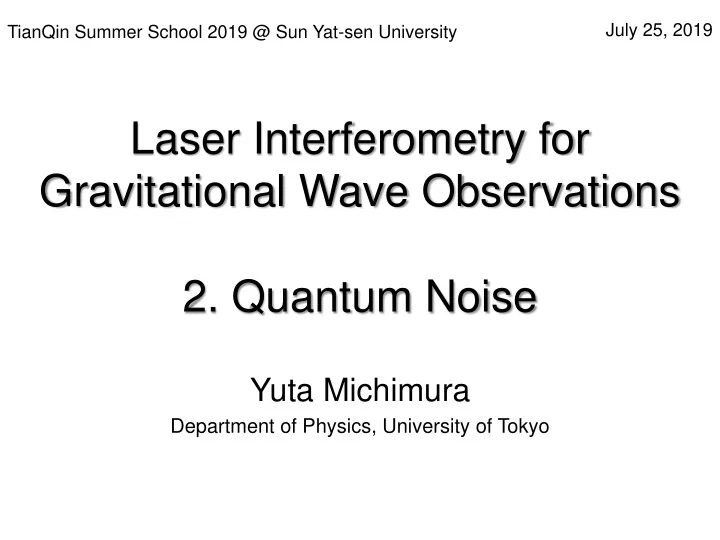

July 25, 2019 TianQin Summer School 2019 @ Sun Yat-sen University Laser Interferometry for Gravitational Wave Observations 2. Quantum Noise Yuta Michimura Department of Physics, University of Tokyo
Contents 1. Laser Interferometers (July 25 PM) Michelson interferometer Fabry-Pérot interferometer 2. Quantum Noise (July 25 PM) Shot noise and radiation pressure noise Standard quantum limit 3. Sensitivity Design (July 26 AM) Force noise and displacement noise Inspiral range and time to merger Space interferometer design 4. Status of KAGRA (July 26 AM) Status of KAGRA detector in Japan 2 Future prospects
Strain Sensitivity of aLIGO • Mostly limited by quantum noise Advanced LIGO design sensitivity Quantum noise 3 LSC, Class. Quantum Grav. 32, 074001 (2015)
Strain Sensitivity of KAGRA • Mostly limited by quantum noise KAGRA design sensitivity Quantum 4 YM+, Phys. Rev. D 97, 122003 (2018)
Quantum Noise • Originated from quantum fluctuation of light Shot noise Fluctuation of number of photons to photodiode Radiation pressure noise Fluctuation of number of photons to mirror • Let’s calculate quantum noise limited sensitivity of gravitational wave detectors! 5
Shot Noise • Number of photons to photodiodes fluctuates Photodiode Photon energy • Quantum fluctuation of power Number of photons Shot noise spectrum Quantum efficiency 6
Shot Noise Limit of Michelson • Power change • Shot noise (recall Lecture 1) • Shot noise limited sensitivity Better shot noise with higher input power Best at dark fringe (where P PD =0) 7
Radiation Pressure Noise • Number of photons to mirror fluctuates Mirror • Power fluctuation Assumed Michelson with input power P 0 Force to Force on displacement mirror • Mirror displacement free-falling mirror 8
Susceptibility • Equation of motion of a suspended mirror • Transfer function from force to displacement Q-value Resonant frequency 9
Standard Quantum Limit • Shot noise is lower with higher power Trade-off • Radiation pressure noise is lower with lower power √ 2 for two arms m is mirror mass (m/2 is reduced mass) Assuming BS with infinite mass • Standard Quantum Limit (SQL) for Michelson from Uncertainty principle 10
Input Power and Sensitivity • SQL cannot be beaten by changing power Michelson (10 W) Shot Michelson (100 W) Michelson (1000 W) 11
Use of Fabry-Pérot Cavities • Still, SQL cannot be beaten (similar effect to increasing the power) Fabry-P é rot-Michelson (100 W, Finesse 100) Michelson (100 W) 12
High-Frequency Response • The effect of gravitational waves cancel at high frequencies Laser FPMI For a given frequency, Michelson there is a limit where longer arm length and higher finesse won’t help increasing the sensitivity 13
FPMI Quantum Noise • Shot noise • Radiation pressure noise 2 for two mirrors of a cavity m is mirror mass (m/4 is reduced mass) • Standard Quantum Limit (SQL) for FPMI 14
Finesse Dependence • Too high finesse narrows the detector bandwidth High frequency sensitivity is not dependent on finesse (nor length) Michelson (100 W) 15
Arm Length Dependence • Longer arm is better (but not at high frequencies) Fabry-P é rot-Michelson Michelson 16
Mirror Mass Dependence • Heavier mass is better for reducing radiation pressure noise Fabry-P é rot-Michelson Michelson 17
Sensitivity Curves of GW Detectors • Now you know how to calculate quantum noise limited sensitivity • Let’s look at the designed sensitivity curves of current and proposed GW detectors • B-DECIGO Space-based Fabry-Pérot interferometer • LISA, TianQin Space-based Optical transponder (similar to Michelson interferometer) • Advanced LIGO, KAGRA Ground-based Fabry-Pérot-Michelson interferometer (with recycling cavities) 18
Sensitivity Curves of GW Detectors LISA: https://perf-lisa.in2p3.fr/ KAGRA: PRD 97, 122003 (2018) TianQin: arXiv:1902.04423 (from Yi-Ming Hu) aLIGO: LIGO-T1800044 B-DECIGO: PTEP 2016, 093E01 (2016) ET: http://www.et-gw.eu/index.php/etdsdocument CE: CQG 34, 044001 (2017) TianQin LISA KAGRA B-DECIGO aLIGO Einstein Telescope Cosmic Explorer 19
B-DECIGO • Consistent with 100 km, 30 kg, 1 W, Finesse 30 (wavelength: 515 nm) B-DECIGO 20
LISA • Shot noise of 2.5e6 km, 3e-12 W Michelson (classical force noise at low frequencies) LISA 21
TianQin • Shot noise of 1.7e5 km, 4e-10 W Michelson (classical force noise at low frequencies) TianQin 22
Optical Transponder • LISA and TianQin uses small amount of light (1-100 pW) due to very long arm length • Amount of light scales with → shot noise floor stays the same (cut-off frequency shifts by ) Laser Laser More power received with shorter arm 23
Advanced LIGO • 4 km, 40 kg, 125x40/0.1 W, Finesse 450*0.1 (power recycling gain 40, signal recycling gain 0.1) aLIGO 24
KAGRA • 3 km, 22.8 kg, 67x10/0.07 W, Finesse 1530*0.07 (power recycling gain 10, signal recycling gain 1/15=0.07) KAGRA 25
Resonant Sideband Extraction • Power Recycling • Resonant Sideband Extraction Power recycling mirror: Effectively increase power ~1 kW Laser ~1 MW ~100 W Signal recycling mirror: Effectively reduce finesse while keeping arm cavity power 26
Some Details Neglected • LISA, TianQin and DECIGO are triangular • DECIGO is locked Fabry-Pérot interferometer (not Fabry-Pérot-Michelson interferometer) • There are other sensing noises such as photodiode noise, laser frequency noise, oscillator phase noise etc... • There are many other classical noises - Seismic noise - Gravity gradient noise (Newtonian noise) - Suspension thermal noise - Mirror coating thermal noise - Other force/displacement noises → To be addressed some in next Lecture 27
Summary • Standard Quantum Limit (SQL) sets certain limit to the sensitivity of laser interferometers • SQL can be reduced with larger mirror mass and longer arm length • Higher power shifts the detector band to higher frequencies • Higher finesse increases the sensitivity at the most sensitive band, but reduces the bandwidth • LISA and TianQin use small fraction of power, and the detector band can be shifted by changing the arm length • Resonant Sideband Extraction technique is used in ground- based detectors to effectively change finesse and power 28
Slides Available Online 1. Laser Interferometers (July 25 PM) https://tinyurl.com/YM20190725-1 2. Quantum Noise (July 25 PM) https://tinyurl.com/YM20190725-2 3. Sensitivity Design (July 26 AM) https://tinyurl.com/YM20190725-3 4. Status of KAGRA (July 26 AM) https://tinyurl.com/YM20190725-4 29
Recommend
More recommend